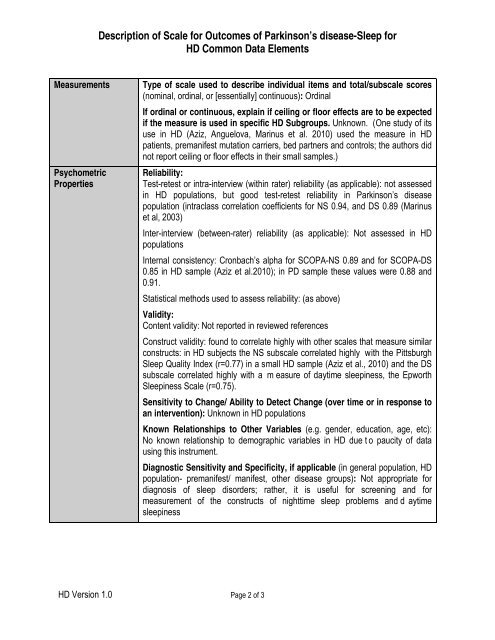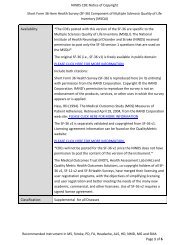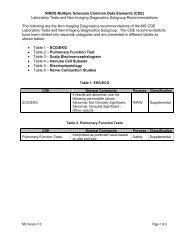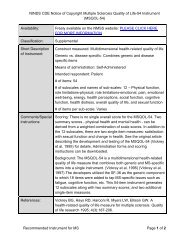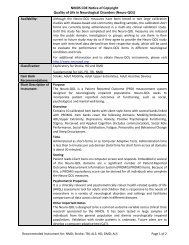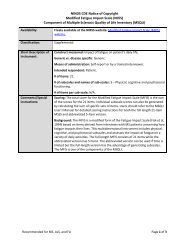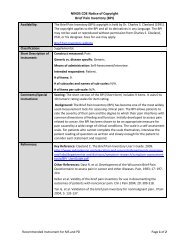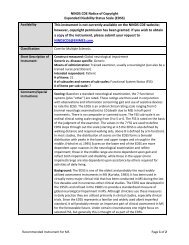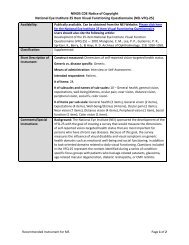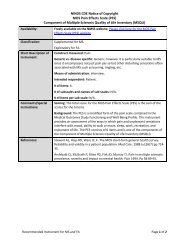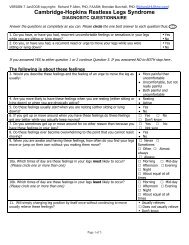NINDS CDE Huntington's Disease Behavioral Psychology Subgroup ...
NINDS CDE Huntington's Disease Behavioral Psychology Subgroup ...
NINDS CDE Huntington's Disease Behavioral Psychology Subgroup ...
You also want an ePaper? Increase the reach of your titles
YUMPU automatically turns print PDFs into web optimized ePapers that Google loves.
Description of Scale for Outcomes of Parkinson’s disease-Sleep forHD Common Data ElementsMeasurementsPsychometricPropertiesType of scale used to describe individual items and total/subscale scores(nominal, ordinal, or [essentially] continuous): OrdinalIf ordinal or continuous, explain if ceiling or floor effects are to be expectedif the measure is used in specific HD <strong>Subgroup</strong>s. Unknown. (One study of itsuse in HD (Aziz, Anguelova, Marinus et al. 2010) used the measure in HDpatients, premanifest mutation carriers, bed partners and controls; the authors didnot report ceiling or floor effects in their small samples.)Reliability:Test-retest or intra-interview (within rater) reliability (as applicable): not assessedin HD populations, but good test-retest reliability in Parkinson’s diseasepopulation (intraclass correlation coefficients for NS 0.94, and DS 0.89 (Marinuset al, 2003)Inter-interview (between-rater) reliability (as applicable): Not assessed in HDpopulationsInternal consistency: Cronbach’s alpha for SCOPA-NS 0.89 and for SCOPA-DS0.85 in HD sample (Aziz et al.2010); in PD sample these values were 0.88 and0.91.Statistical methods used to assess reliability: (as above)Validity:Content validity: Not reported in reviewed referencesConstruct validity: found to correlate highly with other scales that measure similarconstructs: in HD subjects the NS subscale correlated highly with the PittsburghSleep Quality Index (r=0.77) in a small HD sample (Aziz et al., 2010) and the DSsubscale correlated highly with a m easure of daytime sleepiness, the EpworthSleepiness Scale (r=0.75).Sensitivity to Change/ Ability to Detect Change (over time or in response toan intervention): Unknown in HD populationsKnown Relationships to Other Variables (e.g. gender, education, age, etc):No known relationship to demographic variables in HD due t o paucity of datausing this instrument.Diagnostic Sensitivity and Specificity, if applicable (in general population, HDpopulation- premanifest/ manifest, other disease groups): Not appropriate fordiagnosis of sleep disorders; rather, it is useful for screening and formeasurement of the constructs of nighttime sleep problems and d aytimesleepinessHD Version 1.0 Page 2 of 3


